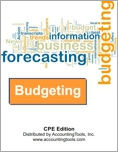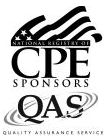Budgeting: A Comprehensive Guide (CPE Course)
CPE Credit: 14 hours
Course Type: Downloaded PDF materials with online test
Price (with PDF Textbook): $100
Course Description
A business may need a well-defined budgeting process in order to estimate its future financial situation and arrange for appropriate amounts of financing and personnel. The Budgeting course provides clarity to the process by showing how to assemble a complete set of budgets, as well as supporting procedures, controls, and reports. The course also addresses several variations on the basic budgeting concept - the flexible budget and the zero-base budget. And for those organizations that prefer to operate without the rigidity of a formal budget, the course discusses how to do so. In short, Budgeting provides the complete toolkit of solutions for building a tailor-made budgeting system.
Author: Steven Bragg
Course Number: FN1013
Table of Contents
Chapter 1. Introduction to Budgeting
Chapter 2. Cost-Volume-Profit Analysis
Chapter 3. The System of Budgets
Chapter 4. The Revenue Budget
Chapter 5. The Ending Finished Goods Inventory Budget
Chapter 6. The Production Budget
Chapter 7. The Direct Materials Budget
Chapter 8. The Direct Labor Budget
Chapter 9. The Manufacturing Overhead Budget
Chapter 10. The Cost of Goods Sold Budget
Chapter 11. The Sales and Marketing Budget
Chapter 12. The Research and Development Budget
Chapter 13. The Administration Budget
Chapter 14. The Capital Budget
Chapter 15. The Compensation Budget
Chapter 16. The Master Budget
Chapter 17. Nonprofit Budgeting
Chapter 18. Flexible Budgeting
Chapter 19. Cost Variability
Chapter 20. The Zero-Base Budget
Chapter 21. Operating without a Budget
Chapter 22. The Rolling Forecast
Chapter 23. Budgeting Procedures
Chapter 24. Budgeting Efficiencies
Chapter 25. Budget Reporting
Chapter 26. Budgeting Controls
Appendix. Sample Budget
Learning Objectives
Specify the advantages and disadvantages of budgeting.
Specify the areas within an organization where there is a bureaucracy supporting the use of budgeting.
Identify the components of cost-volume-profit analysis, and how it can be used.
State the types of budgets that are included in the system of budgets.
Recognize the operating decisions that can impact the system of budgets.
Cite the sources of information for the revenue budget, and note how this budget is used.
Specify how different decisions can impact the amount of finished goods inventory on hand.
Identify how the production budget is compiled, and the issues to consider when constructing it.
Specify how the direct materials budget is compiled.
Identify the components of the direct labor budget, and how it is compiled.
Cite the line items used in the manufacturing overhead budget, and the nature of these costs.
State the sources of the cost of goods sold budget, and the reasons for changes in the expense.
Identify the sales and marketing activities that can affect revenue, as well as the methods used to compile and present the sales and marketing budget.
Specify how the research and development budget is derived, as well as how to review the budget for effectiveness.
Cite the line items usually found in the administration budget.
Identify the methods used to review capital budgeting proposals.
Specify the uses to which a headcount budget is put, and whether bonuses should be included in the budget.
State the components of the master budget, and the factors impacting budgeted asset and liability levels.
Identify the line items used in a nonprofit budget.
Cite the advantages and disadvantages of flexible budgeting.
Identify the situations in which costs can vary, and when they are more likely to be fixed.
State the nature of zero-base budgets and the process for using them, as well as the nature of conditional budgeting.
Specify the role of management in an environment where there is no budget.
Specify the focus of a rolling forecast, and the nature of a continuous budget.
Identify the procedural steps needed to create a budget, including those steps needed to prevent budget slippage and calculation errors.
Cite the methods available for improving the efficiency of the budgeting process, and of the budget model.
State the variances that can be used to compare a budget to actual results.
Identify the controls that can accompany a budgeting process, and what they are intended to accomplish.
Level: Overview
Instructional Method: QAS Self-Study
NASBA Category: Finance
Prerequisites: None
Advance Preparation: None
Latest Review Date: June 2023
Program Registration Requirements: Click on "Purchase Course" near the top of this page to pay for and access the course. You will then be able to download the course as a PDF file, then take an on-line examination, and then download a certificate of completion if you pass the examination.
Program Refund Policy: For more information regarding administrative policies concerning complaints, refunds, and other matters, see our policies page.
AccountingTools, Inc. is registered with the National Association of State Boards of Accountancy (NASBA) as a sponsor of continuing professional education on the National Registry of CPE Sponsors. State boards of accountancy have the final authority on the acceptance of individual courses for CPE credit. Complaints regarding registered sponsors may be submitted to the National Registry of CPE Sponsors through its website: www.nasbaregistry.org.
The NASBA sponsor identification number for Accountingtools, Inc. is 115881.
AccountingTools is an IRS Approved Continuing Education Provider. We are compliant with the requirements for continuing education providers (as described in sections 10.6 and 10.9 of the Department of Treasury’s Circular No. 230 and in other IRS guidance, forms, and instructions). Our IRS Approved Continuing Education Provider number is 72821.


